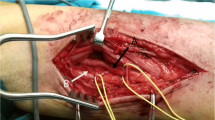Abstract
Introduction
Upper part brachial plexus injuries result in paralysis of Biceps and inability of active elbow flexion. If repair of damaged nerves proves to be impossible, reconstruction surgery will be indicated. Oberlin procedure is a reconstructive method for restoration of elbow flexion in which, posteromedial fascicle of ulnar nerve is transferred to the motor nerve of Biceps. In this article, we evaluated the results of this procedure in 10 patients in whom treatment was performed relatively late.
Method
Ten patients with inability of active elbow flexion due to upper part brachial plexus injury were operated by Oberlin procedure, on average 7 months after the injury.
Results
In 9 patients among 10 patients, active elbow flexion by contracture of biceps muscle was restored and in 8 of them the result was considered to be satisfactory. No complication was observed.
Conclusion
Oberlin procedure is a safe and effective method for restoration of active elbow flexion, in upper part brachial plexus injuries. We did not find a statistically significant correlation between the interval between trauma and surgery, time of first of contraction in biceps and grade of muscle power in biceps at 12 months.

Similar content being viewed by others
References
Hentz VR, Doi K (2005) Traumatic brachial plexus injury. In: Green DP, Hothkiss RN, Pederson WC, Wolfe SW (eds) Green’s operative hand surgery, 5th edn. Elsevier and Churchill Livingstone, Philadelphia, pp 1319–1379
Jobe MT, Martinez SF (2008) Peripheral nerve injuries. In: Canale T, Beaty JH (eds) Campbell’s operative orthopaedics, 11th edn. Mosby, Philadelphia, pp 3635–3704
Chuang DCC (2006) Adult brachial plexus injuries. In: Mathes SJ (ed) Plastic surgery, 2nd edn. Saunders, Philadelphia, pp 515–538
Alnot JY (1988) Traumatic brachial plexus palsy in the adult. Retro- and infraclavicular lesions. Clin Orthop Relat Res 237:9–16
Alnot JY (1995) Traumatic brachial plexus lesions in the adult. Hand Clin 11:113–118
Marshall RW, William DH, Birch R et al (1988) Operative to restore elbow flexion after brachial plexus injuries. J Bone Joint Surg 70B:577–581
Oberlin C, Beal D, Leechavengvongs S et al (1994) Nerve transfer to Biceps muscle using a part of Ulnar nerve for C5-C6 avulsion of the brachial plexus: anatomical study and report of four cases. J Hand Surg 19A:232–237
Chuang DCC, Epstein MD, Yeh MC, Wei FC (1993) Functional restoration of elbow flexion in brachial plexus injuries. J Hand Surg [Am] 18:285–293
Bhandari PS, Sadhotra LP, Bhargava P et al (2008) Multiple nerve transfers for the reanimation of shoulder and elbow functions in irreparable C5, C6 and upper truncal lesions of the brachial plexus. 95 Indian Journal of Neurotrauma (IJNT) 5(2):95–104
Leechavengvongs S, Witoonchart K, Uerpairojkit C et al (1998) Nerve transfer to biceps muscle using a part of the ulnar nerve in brachial plexus injury (upper arm type): a report of 32 cases. J Hand Surg [Am] 23(4):71
Sungpet A, Suphachatwong C, Kawinwonggowit V et al (2000) Transfer of a single fascicle from the ulnar nerve to the biceps muscle after avulsions of upper roots of the brachial plexus. J Hand Surg [Br] 25(4):325–328
Shahriar-Kamrani R, Jafari SM, Guiti MR (2005) The results of using a part of ulnar nerve for restoration of elbow flexion in patients with upper brachial plexus injury. Acta Medica Iran 43(3):204–208
Minami M, Ishii S (1984) Satisfactory elbow flexion in complete (preganglionic) brachial plexus Injuries: produced by suture of third and forth intercostals nerves to musculocutaneous nerve. J Hand surg 12A:1114–1119
Carlstedt T, Grane P, Hallin RG, Noren G (1995) Return of function after spinal cord implantation of avulsed spinal nerve roots. Lancet 346:1323–1325
Bertelli JA, Ghizoni MF (2003) Brachial plexus avulsion injury repair with nerve transfer and nerve grafts directly implanted into the spinal cord yield partial recovery of shoulder and elbow movements. Neurosurgery 52:1385–1390
Merrell GA, Barrie KA, Katz DL, Wolfe SW (2001) Results of nerve transfer techniques for restoration of shoulder and elbow function in the context of a meta-analysis of the English literature. J Hand Surg Am 26(2):303–314
Venkatramani H, Bhardwaj P, Faruquee SR, Sabapathy SR (2008) Functional outcome of nerve transfer for restoration of shoulder and elbow function in upper brachial plexus injury. J Brachial Plex Peripher Nerve Inj 3:15
Conflict of interest statement
No funds were received in support of this study.
Author information
Authors and Affiliations
Corresponding author
Rights and permissions
About this article
Cite this article
Zyaei, A., Saied, A. Functional outcome of ulnar nerve fascicle transfer for restoration of elbow flexion in upper brachial plexus injury. Eur J Orthop Surg Traumatol 20, 293–297 (2010). https://doi.org/10.1007/s00590-009-0558-z
Received:
Accepted:
Published:
Issue Date:
DOI: https://doi.org/10.1007/s00590-009-0558-z




